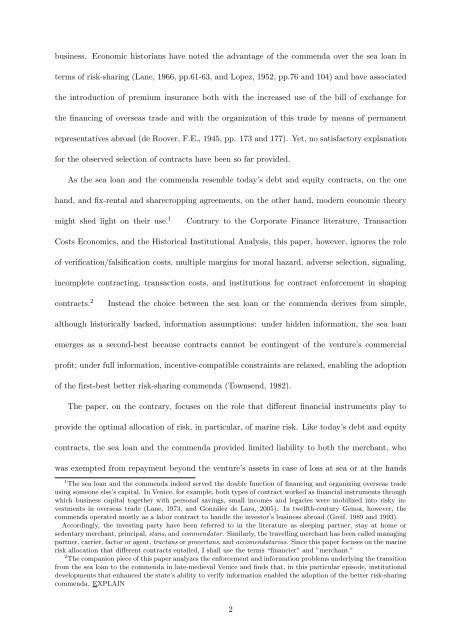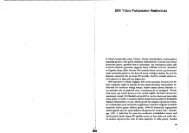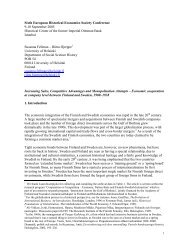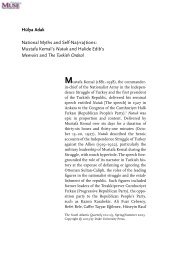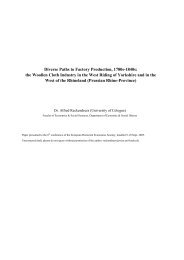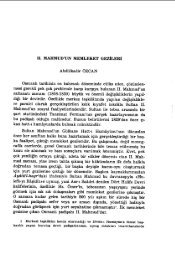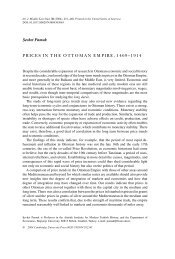The Birth of Insurance Contracts - The Ataturk Institute for Modern ...
The Birth of Insurance Contracts - The Ataturk Institute for Modern ...
The Birth of Insurance Contracts - The Ataturk Institute for Modern ...
Create successful ePaper yourself
Turn your PDF publications into a flip-book with our unique Google optimized e-Paper software.
usiness. Economic historians have noted the advantage <strong>of</strong> the commenda over the sea loan in<br />
terms <strong>of</strong> risk-sharing (Lane, 1966, pp.61-63, and Lopez, 1952, pp.76 and 104) and have associated<br />
the introduction <strong>of</strong> premium insurance both with the increased use <strong>of</strong> the bill <strong>of</strong> exchange <strong>for</strong><br />
the financing <strong>of</strong> overseas trade and with the organization <strong>of</strong> this trade by means <strong>of</strong> permanent<br />
representatives abroad (de Roover, F.E., 1945, pp. 173 and 177). Yet, no satisfactory explanation<br />
<strong>for</strong> the observed selection <strong>of</strong> contracts have been so far provided.<br />
As the sea loan and the commenda resemble today’s debt and equity contracts, on the one<br />
hand, and fix-rental and sharecropping agreements, on the other hand, modern economic theory<br />
might shed light on their use. 1 Contrary to the Corporate Finance literature, Transaction<br />
Costs Economics, and the Historical Institutional Analysis, this paper, however, ignores the role<br />
<strong>of</strong> verification/falsification costs, multiple margins <strong>for</strong> moral hazard, adverse selection, signaling,<br />
incomplete contracting, transaction costs, and institutions <strong>for</strong> contract en<strong>for</strong>cement in shaping<br />
contracts. 2 Instead the choice between the sea loan or the commenda derives from simple,<br />
although historically backed, in<strong>for</strong>mation assumptions: under hidden in<strong>for</strong>mation, the sea loan<br />
emerges as a second-best because contracts cannot be contingent <strong>of</strong> the venture’s commercial<br />
pr<strong>of</strong>it; under full in<strong>for</strong>mation, incentive-compatible constraints are relaxed, enabling the adoption<br />
<strong>of</strong> the first-best better risk-sharing commenda (Townsend, 1982).<br />
<strong>The</strong> paper, on the contrary, focuses on the role that different financial instruments play to<br />
provide the optimal allocation <strong>of</strong> risk, in particular, <strong>of</strong> marine risk. Like today’s debt and equity<br />
contracts, the sea loan and the commenda provided limited liability to both the merchant, who<br />
was exempted from repayment beyond the venture’s assets in case <strong>of</strong> loss at sea or at the hands<br />
1 <strong>The</strong> sea loan and the commenda indeed served the double function <strong>of</strong> financing and organizing overseas trade<br />
using someone else’s capital. In Venice, <strong>for</strong> example, both types <strong>of</strong> contract worked as financial instruments through<br />
which business capital together with personal savings, small incomes and legacies were mobilized into risky investments<br />
in overseas trade (Lane, 1973, and González de Lara, 2005). In twelfth-century Genoa, however, the<br />
commenda operated mostly as a labor contract to handle the investor’s business abroad (Greif, 1989 and 1993).<br />
Accordingly, the investing party have been referred to in the literature as sleeping partner, stay at home or<br />
sedentary merchant, principal, stans, and commendator. Similarly, the travelling merchant has been called managing<br />
partner, carrier, factor or agent, tractans or procertans, and accomendatarius. Since this paper focuses on the marine<br />
risk allocation that different contracts entailed, I shall use the terms “financier” and ”merchant.”<br />
2 <strong>The</strong> companion piece <strong>of</strong> this paper analyzes the en<strong>for</strong>cement and in<strong>for</strong>mation problems underlying the transition<br />
from the sea loan to the commenda in late-medieval Venice and finds that, in this particular episode, institutional<br />
developments that enhanced the state’s ability to verify in<strong>for</strong>mation enabled the adoption <strong>of</strong> the better risk-sharing<br />
commenda. EXPLAIN<br />
2


